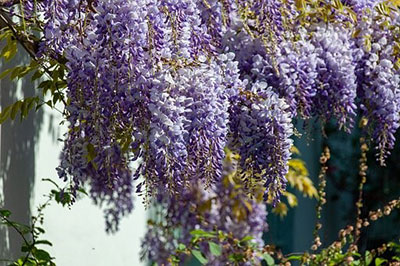Wisteria

Wisteria is a beautiful vining perennial growing 25-30 feet long. This vine is known for its beautiful long clusters of flowers. The flower color of wisteria depends on the variety but ranges from white to pink to deep reddish to bluish-violet. Once the flowers have disappeared, bean-like pods appear and remain so through the winter. One complaint about wisteria is often that the vines simply are not blooming. Some wisteria vines will need 7 to 15 years to produce their first flowers, and excessive nitrogen fertilizer may stimulate leaf and stem growth but inhibit flower formation. Some practices can help induce flowering, including an application of superphosphate fertilizer in the spring, severe pruning of new development in late spring or early summer, and finally, root pruning (cutting the roots with a spade a few feet from the trunk) in the fall. Purchasing grafted plants from the nursery is best to speed up the blooming process.
Wisteria is a perfect option to train along a fence or on stoutly constructed arbors or pergolas. These vines are also an excellent option over patios or open structured roofs. Wisteria will need regular pruning to keep the vine in check throughout the growing season, so this is not a low-maintenance plant. This is also not a plant to use climbing up a tree or near another desirable shrub, as they will choke them out. There are two main types of wisteria: the Japanese wisteria and the Chinese wisteria. The latter is more commonly grown in gardens as all the blooms open simultaneously provide a better flower display than Japanese wisteria.

Have questions? Contact our office where our Horticulture Extension Agent will assist you with questions.
Phone: (316) 321-9660
Email: callae@ksu.edu